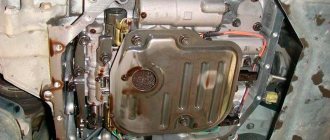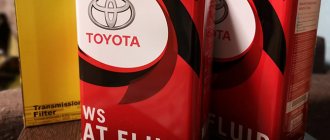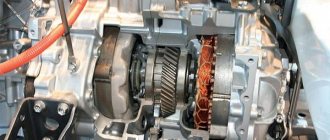Hello everyone and good day. This article will help you distinguish original Toyota oil from counterfeit ones. The counterfeit does not meet the standards and quality that are required for it, so the parts of the engine or gearbox containing the counterfeit are destroyed. Knowing the distinctive features, you will be able to purchase only original products, avoiding expensive repairs later.
Front side of the canister
- The text on the label is clear and easy to read. The texture has transitions from dark to light areas with noticeable levels.
- At the bottom there is a batch code (production date and manufacturer).
Characteristics and Application
Toyota 0w30 synthetic motor oil, intended primarily for Toyota vehicles. The lubricant is recommended for use in cold Russian climates.
This is evidenced by the so-called “winter” viscosity index 0W. This index indicates the possibility of using this product down to a temperature of – 40 C°.
The car manufacturer itself does not produce motor oils, but purchases them from some well-known oil manufacturer. Most likely, this is the famous oil giant ExxonMobil.
Now let’s take a break from marketing and look at what Toyota 0w-30 oil actually represents. Viscosity 0W30 indicates all-season use in gasoline and diesel engines equipped with catalytic converters and particulate filters.
The manufacturer guarantees easy engine starting in the cold season due to good fluidity and a very low pour point.
note
In practice, the test confirmed a significant loss of fluidity already at – 30 C°. This fact does not play in favor of the Toyota 0w 30, since in Russia in many regions the temperature drops to lower values.
It has long been proven that the greatest engine wear occurs during cold starts. This means that when using such oil at temperatures lower than -30, engine wear will inevitably occur.
Here I will add that oils with more modest declared characteristics and prices performed better in this discipline. As for the high-temperature characteristics of Toyota 0w-30, according to the manufacturer, the flash point is a rather modest 224 C°.
In reality, this parameter results in increased oil consumption due to waste, especially when operating in the city. I also do not recommend this lubricant for “active drivers”; due to its modest high-temperature performance, this oil will simply burn out.
Based on the foregoing, Toyota 0w-30 oil is a product of hydrocracking synthesis with the addition of PAO and a package of additives to the base.
Quite modest, considering the price and the very big name on the label. The table shows the main characteristics of motor oil.
Lid
Here you need to be extremely careful, there are two types of original lids on the market and many of the original ones are attributed to a fake, which is fundamentally wrong. This oil is produced by two factories - France and Italy.
On the left is France, has no opening instructions. On the right is Italy, with instructions for opening the lid. Both canisters are original.
- The cap of the original Toyota oil fits tightly, without any gaps, to the canister.
- It has a homogeneous, integral structure.
- There is a tear-off edge.
- Compare the manufacturer's label with the factory code and the cap. The original Toyota oil canister, made in France, does not have opening instructions on the lid. Oil bottled in Italy is produced with instructions.
Quality of the original product
The original product 5 40 has the following indicators:
- High protection of parts from destruction/wear;
- Excellent degree of cleaning of elements from carbon deposits and other contaminants;
- The best level of corrosion protection;
- It will not thicken in cold weather, which allows you to start the engine in winter without problems;
- Reduced friction of parts saves fuel;
- Increases the service life of all Toyota automatic transmission parts and engines;
- Versatility, can be used in cars, trucks or buses;
Base (bottom) of an oil canister
- The surface is ribbed.
- The seam is even.
- Numbers and symbols are clearly printed, without any differences.
You can buy original Toyota oil! Follow these instructions, soberly evaluate your choice, expensive is not necessarily original. After studying a lot of materials, we came to the conclusion that 9 out of 10 canisters can be identified as a fake by the front part without holding the canister in your hands. The inspection plan should be as follows:
- We look at the fonts (SYNTHETIC), the number 5 and the smooth transition of the dark color to yellow - usually this is enough to go to the next store. Yes, the statistics on the amount of fake oil are terrible. There are more fakes on the shelves than the originals.
- We look at the lid, if there are instructions on the lid, then the manufacturer should be on the label - Italy. There are no instructions - the manufacturer must be France.
- We examine the bottom - the numbers and symbols are read perfectly.
The oil manufacturer decided to change the back label . And at the moment, the back side of the original Toyota oil may look like this:
An EAC code was added to the label, an inscription appeared in Russian, and the ending GO was added to the article number.
Consequences of falling for a fake
Today, a lot of counterfeits of original oils are produced, this is beneficial for artisanal manufacturers. However, such motor oil does not meet the requirements and quality standards, and Japanese engines are extremely sensitive to the quality of the lubricant. The counterfeit reduces the performance of the Camry engine (and other models), the durability of its operation before major repairs, and causes various breakdowns:
- The engine may not start at all, producing various errors;
- Carbon deposits on the valves and in the cylinders increase, which leads to interruptions in engine operation and rapid wear of CPG parts and destruction of the valves;
- Due to clogging of the lubrication channels, rapid destruction of all rubbing elements of the motor occurs;
- Foaming is possible, which reduces lubricity and impairs the supply of oil to parts;
- It is also not advisable for counterfeit or lubricant not intended for it to get into the transfer case. The results will be the same as with a manual transmission - increased noise, wear and jamming when switching.
- If a counterfeit gets into the box, the machine will quickly break its parts; after the counterfeit, you will have to buy a new transmission, and this is not cheap;
- A manual transmission reacts to a fake - like an old lubricant that has not been changed for a long time - the appearance of squeaks, knocking, poor gear shifting. I myself witnessed a case when a mechanic at a service station won an argument. He bet that if you change the transmission oil in the manual transmission, it will eliminate all extraneous noise and knocking - and so it happened!
- Starting the engine may be difficult due to contamination of the spark plugs or engine sensors;
- You forget that branded lubricant, for example 0w30, is designed to withstand temperature changes; it does not thin out in the heat of summer and does not thicken in cold winters. On a fake, in winter the engine does not start at all or starts poorly. Long attempts to start a cold engine wear out the liners and piston rings.
- If a counterfeit gets into the power steering, it not only harms its parts, but can affect the control of the car. A malfunction of the steering wheel while the vehicle is moving is life-threatening.
We draw a conclusion
By checking the canister according to our instructions, you can make the right choice in the store. And if you placed an order online, then save these instructions in your bookmarks or on your social network pages. When you receive the goods, open it and compare the oil that arrived. You can refuse the purchase and get your money back.
Remember - we can only distinguish the packaging! Unfortunately, it is practically impossible to determine visually what is inside.
In conclusion, we suggest watching a video about the distinctive features of the canisters. It also tells what is poured into Toyota cans.
Many Toyota car owners, knowing about the huge market for counterfeit oils, prefer to fill their cars with oil, not what the manufacturer advises. However, by using your brains and studying our recommendations, any car owner can buy real oil. That's all, make the right choice.
Articles for ordering Toyota oil in online stores
| Old article | New article | Viscosity | Displacement |
| 0888080360 | 0888080360GO | 0W30 | 208l |
| 0888080365 | 0888080365GO | 0W30 | 5l |
| 0888080366 | 0888080366GO | 0W30 | 1l |
| 0888080370 | 0888080370GO | 5W40 | 208l |
| 0888080375 | 0888080375GO | 5W40 | 5l |
| 0888080376 | 0888080376GO | 5W40 | 1l |
| 0888083264 | 0888083264GO | 0W20 | 1l |
| 0888083265 | 0888083265GO | 0W20 | 5l |
| 0888083266 | 0888083266GO | 0W20 | 208l |
| 0888083388 | — | 5W30 | 1l |
| 0888083389 | — | 5W30 | 5l |
Metal containers
Toyota oil is produced both in cans and in metal cans. This, first of all, applies to the composition of Toyota 5W30 - it is produced only in metal containers, painted in two colors - silver and red. The volume is usually 4 liters. The first thing you should pay attention to is who the manufacturer is. This must be ExxonMobil Yugen Kaisha Co., Ltd, Tokyo 108-80005. The container may contain two types of oil: Toyota 5W30 SL (synthetic) and Toyota 5W30 SM (semi-synthetic).
You can also find Toyota 5W30 SN oil fluid produced in Singapore on the market; 3-liter and one-liter jars are used for bottling it. Toyota 5W30 API SN ILSAC GF-5 is also a 100% Japanese product - so far no counterfeits of this oil have been found in metal containers.
Recently, elongated cans (3 liters) have appeared on sale. It seems that everything is the same, the inscription is the same - Toyota 5W30 SN GF-5, but there is one nuance that buyers do not pay attention to. Fanfaro is written in small letters on the container. That is, under the guise of Toyota, a completely different lubricant is sold. To distinguish this fake, you need to turn the jar - you will see this inscription on the side wall at the top (see photo below).
Release form and article numbers for ordering
Toyota 0w-30 is bottled in 1.4 and 5 liter containers; you can also purchase this lubricant in 20 liter containers. Toyota 0w30
- 1 l., art. 08880-80366;
- 4 l., art. 08883-02905;
- 5 l., art. 08880-80365;
- 20 sheets, art. 08883-02903;
- Premium Fuel Economy 0W30, 1 l., art. 08880-82870;
- Premium Fuel Economy 0W30, 5 l., art. 08880-82871.
LEXUS 0W30
- 1 l., art. 08880-82644;
- 5 l., art. 08880-82645;
Why use Toyota engine oil
You need to understand that all Toyota lubricants are manufactured according to the quality standards established for Japanese cars. Therefore, their use in Toyota or Lexus vehicles is more than justified. Pouring original lubricants into the engine and other units, all other things being equal, guarantees that there will be no problems caused by the oil.
If the viscosity and other tolerances allow the use of oil in Japanese cars from others, it can be poured into this equipment. This will also be justified.
Using lubricants from Toyota in European and American cars is not the best solution. Not because the oil is not suitable. But because for the price of lubricants from a Japanese manufacturer you can buy top-end oil from other brands.
Looking at the back label
See also
How to distinguish a mink from a fake using instructions with a photo
Here look at the quality of the print, as well as the text itself and the contents of the sticker.
Copies are distinguished by the presence of fakes and inaccuracies. Smeared ink, spelling and punctuation errors have become the norm for copies.
The Toyota logo can be black or gray. While the genuine canister is silver. The Toyota brand name is approximately the same color as the cover. They are different for the copy.
Printing on labels
The original manufacturer applies the highest quality labels. Printing is performed on specialized equipment. Each sign and symbol is easy to read. There are no shortcomings or errors.
Look at the colors of the labels. It is bright, rich, with clear lines and images.
A characteristic sign of a fake is low quality printing. The images are blurry, the numbers are blurry. The colors are dull and darkened. It's like it's a photocopier and not a print.
Tolerances and specifications
Toyota 0w-30 is an original motor oil approved for use in gasoline and diesel engines of the TOYOTA concern, both during first filling and during scheduled maintenance.
Toyota 0w30 is also approved for use in the engines of LEXUS cars, which are the luxury brand of the concern. A study by the American Petroleum Institute of Toyota 0w-30 oil confirmed its compliance with the newest quality group N.
The Association of European Automobile Manufacturers ACEA has confirmed the compliance of Toyota 0w-30 oil with specifications A1/B1, A3/B4, A5/B5.
The presence of this specification confirms the possibility of use in engines of other car manufacturers with the same requirements.
How to spot a fake?
When my car was hanging on a lift, the mechanic came up to me and asked if I was sure that the fluid I had brought was poured into my engine.
The master demonstrated the difference in fluidity of the oil that I brought and the one I brought from the warehouse. After which I decided not to risk it and fill in the one offered by the dealer.
The canister I bought was sent to the laboratory, and the analysis cost 4,800 rubles. The conclusion, as you guessed, is simple: the presented sample does not correspond to the declared characteristics.
The conclusion is simple: buying oil even in a reputable and well-known online store will not protect you from counterfeits. Buy the original product only from authorized dealers.
Some ways to spot a fake:
- The canister lid, original with embossing and visual instructions on how to open it, is smooth on the fake.
- The front label has a clear, uniform image, but the fake one has a slightly blurred and unclear image. The label may have been applied unevenly.
- The back label of the original is single with clear inscriptions, while the back label of the fake is double, glued on top of each other.
- Particular attention to the “TOYOTA” logo on the fake shows a weaker printing resolution along the contour and the general perception of the image as less prominent.
Learning to distinguish a fake - video
Advantages and disadvantages
- Full compliance with the requirements of the car plant.
- High protective properties.
- Good fuel economy figures.
- Excellent cleaning properties.
- High-quality additive package.
The disadvantages include:
- Weak low-temperature properties.
- Possible waste due to low flash point.
- High probability of buying a fake.
Engine after running 100 thousand on Toyota 0w-30 oil. Perfect cleanliness.











